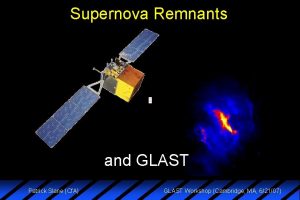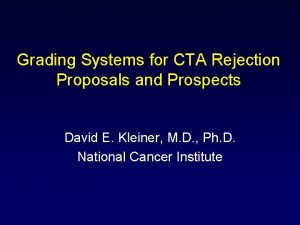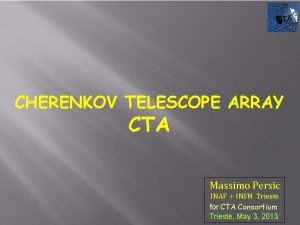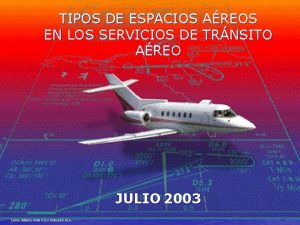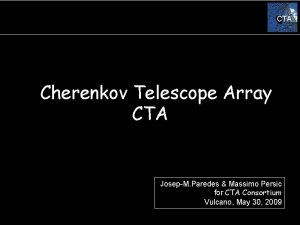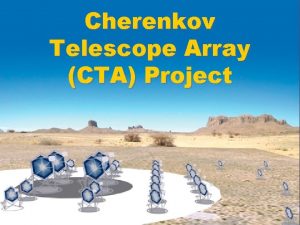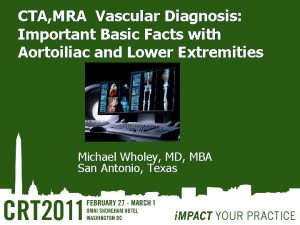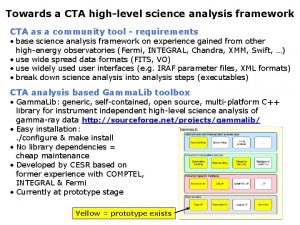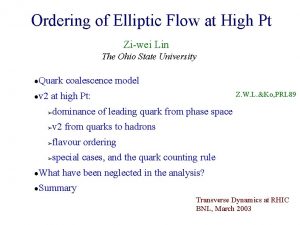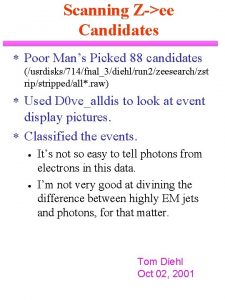SNRs as Pe Vatron candidates for CTA Ziwei





















- Slides: 21

SNRs as Pe. Vatron candidates for CTA Ziwei Ou Institut de Physique Nucléaire d’Orsay Université Paris-Sud Supervisor: Tiina Suomijärvi 2018|10|08 1

● Cherenkov Telescope Array ● Supernova Remnants as Pe. Vatron candidates ● Naima and model fitting ● Main results ● Summary 2

Cherenkov Telescope Array (CTA) Small-sized telescopes (SST): 1 Te. V - 300 Te. V Medium-sized telescopes (MST): 100 Ge. V - 10 Te. V Large-sized telescopes(LST): 20 Ge. V- 200 Ge. V North site: La Palma (Spain) South site: Paranal (Chile) 3

CTA detect the Cherenkov light induced by gamma-ray 4

LST, 2017 -11, La Palma, Spain 5

MST, 2018 -09, DESY, Germany 6

CTA: Cosmic-rays Pe. Vatron as a Key Science Project (KSP) from Rene Ong (2015) 7

Cosmic-Rays accelerated up to 1 Pe. Vatrons: astrophysical object accelerated particles above 1 Pe. V (10^15 e. V). The energy of spectrum of Cosmic-Rays (CRs) extends until few Pe. V where it steepens originating the ‘knee’. Theoretical prediction and measurements of CR indicate that the CR should be accelerated up to 1 Pe. V in our Galaxy. 8

Supernova Remnants (SNRs) as promising Galactic Pe. Vatron candidates The detection of SNRs with spectrum up to 100 Te. V imply that they are one kinds of Pe. Vatron candidates, because ~100 Te. V photons are produced by ~ Pe. V protons. (observation) SNRs are able to satisfy the cosmic-ray energy requirement by converting the kinetic energy into accelerated particle. (theory) SNRs (and Pulsar Wind Nebulae) are the majority of Galactic poululation. 9

Proton-proton collision induces pion decay For accelerated protons, hadronic interactions with ambient matter produce neutral pion, decaying into two γ-ray photons 10

DC-1 data, Prod 3 b IRF and ctools Data Challenge one (DC-1): simulated data enable the CTA Consortium Science Working Group to derive science benchmarks for the CTA KSP. DC-1 includes Galactic Plane Scan (GPS) as one of the key science projects. We use GPS data to analysis SNRs. Prod 3 b Instrumental Response Functions (IRFs): the performance values are derived from Monte Carlo simulation of CTA instrument based on the CORSIKA air shower code. Ctools: a soft package developed for scientific analysis of CTA data. We run ctools pipeline to judge whether SNRs from Te. VCat are considered in DC-1 GPS, and to draw the spectrums. 11

Low Galactic latitude from Te. VCat 12

13

14

Naima python package 15

Radiation mechanism for SNRs Four main non-thermal radiative mechanisms for producing γ-ray Synchrotron pion-decay 16

Electron and proton follow exponential cutoff power-law 17

18

HESS J 1731 -347 Spectral Energy Distribution 19

20

Summary Proton cut-off energy values as Pe. Vatron indicators. Distinguish pion-decay or inverse Compton process dominate SNRs radiation. I do not consider the energy dispersion. Reset the XML model definition file to smooth residuals maps. 21

